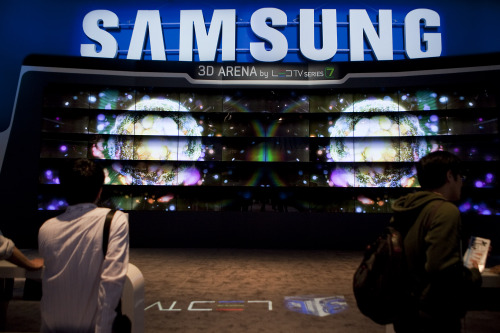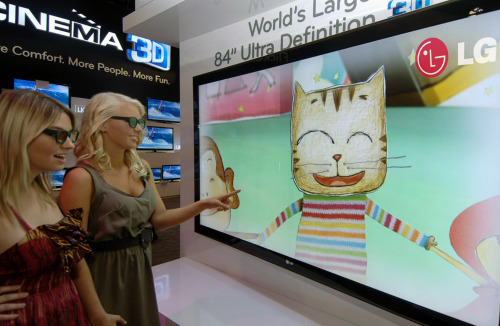The recent success of the Hollywood blockbuster “Avatar” triggered a stream of 3D films meaning that moviegoers are now often seen in theaters armed with special 3D glasses as well as popcorn.
Reflecting the growing popularity, IT companies from home and abroad unleashed jumbo-sized 3D TVs with enthusiasm at the Consumer Electronics Show held in Las Vegas during the second week of this year.

Samsung and LG both showcased huge 3D vision televisions, as did Sony and Toshiba from Japan.
“It will take some time for 3D technology to really take off, and there are still a lot of glitches that need to be ironed out, such as the dizziness that accompanies 3D vision, but 3D is definitely going to be in vogue,” said Jang Sung-won, a researcher at Samsung Economic Research Institute.
Display Research, a market research firm, said on Jan.12 that the 3D TV market will grow by about five-fold this year to 18 million sets. By 2014, it predicted that the market will surge to over 90 million.
As the industry branches out, some of the major complaints consumers had about 3D vision are expected to be addressed.
For instance, the clunky eyewear that 3D requires is to become savvier and more wearable as companies rush to introduce lighter and more fashionable glasses.

LG and Samsung joined up with leading fashion houses to roll out such 3D eyewear at the CES this year.LG Display introduced new glasses based on its cutting-edge 3D technology that it claims to be both affordable and more comfortable.
“We have cut out side effects such as crosstalk and flickering to make it easier and more convenient for users to watch 3D images,” said Kwon Young-soo, the company CEO.
Going a step further, firms also tested the waters for autosterescopic technology, which makes 3D vision possible without the aid of eyewear.
Japan’s Toshiba went so far to say that it will be commercializing this technology for television in North America before March this year.
Samsung Electronics, however, said it was too early to know whether autostereoscopic technology can take off, as the technology is still in its early stages. It pointed out that to watch 3D TV without glasses, consumers must stand in designated areas.
LG Electronics argued the timing was right, saying autostereoscopic technology will first be applied to smaller mobile devices, then move on to bigger devices such as TVs.
“It’s much easier to watch 3D without glasses from a smaller screen since users usually watch from a limited distance, so this is where the new technology will take off from,” said Cho Joong-kwon, a spokesman for LG Electronics.
(jemmie@heraldcorp.com)
최근 영화 ‘아바타’의 성공은 3D의 유행을 가져왔다. 이러한 경향을 반영, 2011년 1월 개최된 CES에서 국내외 업체들은 대형 3D TV를 선보였다.
삼성전자와 LG전자는 자체적으로 생산한 3D TV를 공개했으며 일본의 소니와 도시바 역시 같은 계열의 제품을 전면에 내세웠다.
삼성경제연소의 장성원 연구원은 ‘3D 기술이 인기를 끌기까지는 어느 정도 시간이 걸릴 것’이라며 3D로 화면을 볼 때 생기는 어지러움과 같은 문제를 해결해야 한다고 지적했다.
시장조사기관인 디스플레이 리서치는 3D TV 시장이 올해 5배 성장해 1800만대에 이를 것이라고 예측했다. 2014년에는 9000만대로 시장이 확대될 것이라고 밝혔다.
시장 확대는 소비자들의 불만을 해소할 가능성을 높아짐을 의미한다. 예를 들이 현재 거추장스러운 3D 안경의 경우 좀 더 발전해서 가벼워지고 화려해지는 방향으로 갈 것으로 예상된다.
LG디스플레이는 새로운 최첨단 3D기술에 기반한 안경을 선보였는데 가격적으로 좀 더 경쟁력이 있고 보다 편안한 착용감을 준다고 밝혔다.
궁극적으로는 3D를 보기 위해 특수한 안경이 필요 없는 기술개발 경쟁이 진행중이다. 일본의 도시바는 이러한 기술을 올해 3월 전에 북미시장에서 상용화 할 계획이라고 밝혔다.
삼성전자는 관련 기술이 아직 초기단계에 있다는 점을 근거로 시장에서 받아들여질지는 지켜봐야 한다는 입장이다.
LG전자는 3D안경이 필요 없는 3D기술이 일단 작은 모바일 기기에 먼저 적용되고 이후 TV에 채택될 것으로 전망했다.








![[Graphic News] More Koreans say they plan long-distance trips this year](http://res.heraldm.com/phpwas/restmb_idxmake.php?idx=644&simg=/content/image/2024/04/17/20240417050828_0.gif&u=)
![[KH Explains] Hyundai's full hybrid edge to pay off amid slow transition to pure EVs](http://res.heraldm.com/phpwas/restmb_idxmake.php?idx=644&simg=/content/image/2024/04/18/20240418050645_0.jpg&u=20240419100350)





![[From the Scene] Monks, Buddhists hail return of remains of Buddhas](http://res.heraldm.com/phpwas/restmb_idxmake.php?idx=652&simg=/content/image/2024/04/19/20240419050617_0.jpg&u=20240419175937)

![[KH Explains] Hyundai's full hybrid edge to pay off amid slow transition to pure EVs](http://res.heraldm.com/phpwas/restmb_idxmake.php?idx=652&simg=/content/image/2024/04/18/20240418050645_0.jpg&u=20240419100350)

![[Today’s K-pop] Illit drops debut single remix](http://res.heraldm.com/phpwas/restmb_idxmake.php?idx=642&simg=/content/image/2024/04/19/20240419050612_0.jpg&u=)